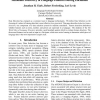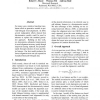23 search results - page 3 / 5 » Structural Feature Selection For English-Korean Statistical ... |
ACL
2006
13 years 5 months ago
2006
Certain distinctions made in the lexicon of one language may be redundant when translating into another language. We quantify redundancy among source types by the similarity of th...
LREC
2008
13 years 5 months ago
2008
Data Selection has emerged as a common issue in language technologies. We define Data Selection as the choosing of a subset of training data that is most effective for a given tas...
ACL
2012
11 years 6 months ago
2012
Long-span features, such as syntax, can improve language models for tasks such as speech recognition and machine translation. However, these language models can be difficult to u...
ANLP
1994
13 years 5 months ago
1994
The authors propose a model for analyzing English sentences including coordinate conjunctions such as "and","or","but" and the equivalent words. Synt...
ACL
2006
13 years 5 months ago
2006
For many years, statistical machine translation relied on generative models to provide bilingual word alignments. In 2005, several independent efforts showed that discriminative m...


